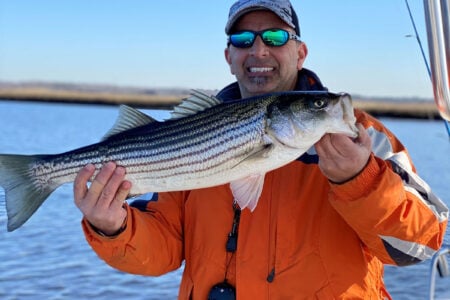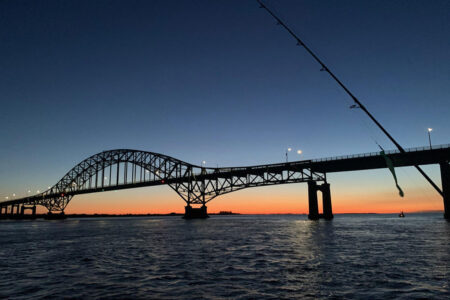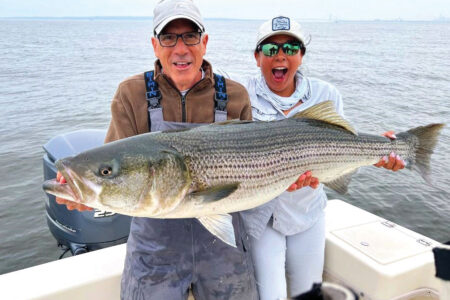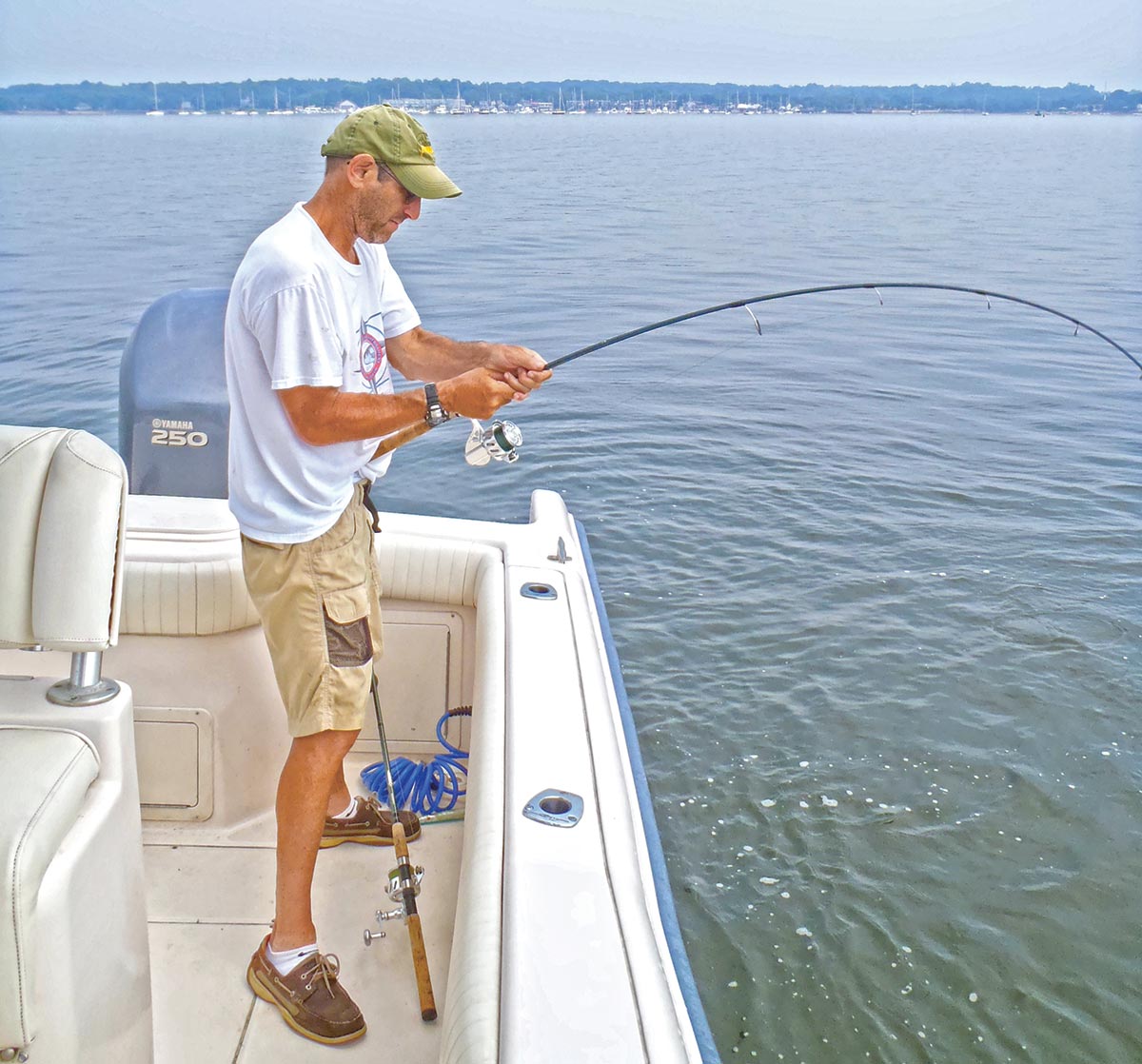
North Shore harbors serve up good sport with schoolie stripers during the dog days of summer.
Considering that big bluefish have been mostly absent from North Shore harbors the last two years, shallow water boat fishermen have stepped up their pursuit of school stripers in the backs of the harbors. Rich Lazar and I keep hoping there will be at least a short intrusion of big blues in the summer, but with the bluefish population down 50 percent since 1981, optimism becomes weaker and weaker each season. So instead of teeth, we shoot for stripes.
School Bass
The striped bass population has also shrunk, although less compared to bluefish. The population is also skewed toward little fish, which means opportunities for small stripers will be much better than for large ones. I don’t feel I’m losing anything by chasing these small fish, and Rich agrees with me, because if an angler lightens up on the tackle and uses smaller lures, there’s a ton of fun available. It doesn’t hurt that it’s summer, and the weather easy and tranquil, making boat control simpler and searching for fish a snap. Like all forms of fishing in today’s arena, there is no guarantee of success, and an angler should commit to sharpening their skills to achieve more consistent success. But, let’s leave that for later and begin a discussion about tackle.
Line: I only use 15- or 20-pound test braided line for light tackle fishing, and I wonder sometimes if it’s unkind of me to disparage wannabe light tackle anglers who pack a 100- or 200-hundred size reel with 40- or 50-pound test braid. Then I remember that they use heavy braid for the same reasons they once used heavy mono: fear of breaking off a big fish, and poor knot strength. The knot problem is easy to solve, but of course an angler needs to be interested in solving it. Here’s how. Discard all the fancy knots you see on television, because you don’t need them. An angler only needs one simple knot to tie braided running line to a small swivel, and the leader to the other end of it: an improved clinch knot. There are, like any other knot, a few keys to achieving a good knot. First, make 10 wraps with braid instead of the five we use for mono because braid is slippery. Second, wet the knot before pulling it tight. Third, pull on the tag end of the line as well as the running line. Fourth, check to see that the coils are stacked neatly like a bunch of coins. Fifth, if you spot any bulges or overlaps, cut the line and tie again. When tied correctly, the improved clinch knot has 95 percent of the line’s pound-test strength, and when tied with braid the knot lasts a long time.
Remember that casting distance and accuracy are related to line thickness. Therefore, 40- or 50-pound test line will shorten your cast substantially. Heavy line also decreases accuracy. Also, light tackle fishing is finesse fishing and involves lightweight lures. Light lures and heavy braid are a poor combo because there is a tendency to produce “wind” loops on the cast and loose loops on the spool when retrieving.
As far as breaking off a good fish goes, that fear should all but disappear with a good knot and good tackle. Do a little testing of 15- and 20-pound braid in the comfort of your backyard. Tie it to progressively heavier things and pull each until the line breaks. Make sure the object can roll or slide easily. I think you’ll be amazed at how much weight you can safely pull with 20-pound test braided line. Once you have a good knot, the ability to land bigger fish will lie in the skill of the angler and the quality of the rod and reel. I’ve fished with guys who lock down their drags and then wonder why they broke off a teen blue or straightened a hook. The drag is there for a reason, so use it. Of course, cheap reels sometimes have cheap drags that stutter. An erratic drag will also tend to break off fish because a sudden surge from the fish without a sliding release allows the full force of the pull to be placed on the knot and/or hook. Quality tackle equates to better fish control.
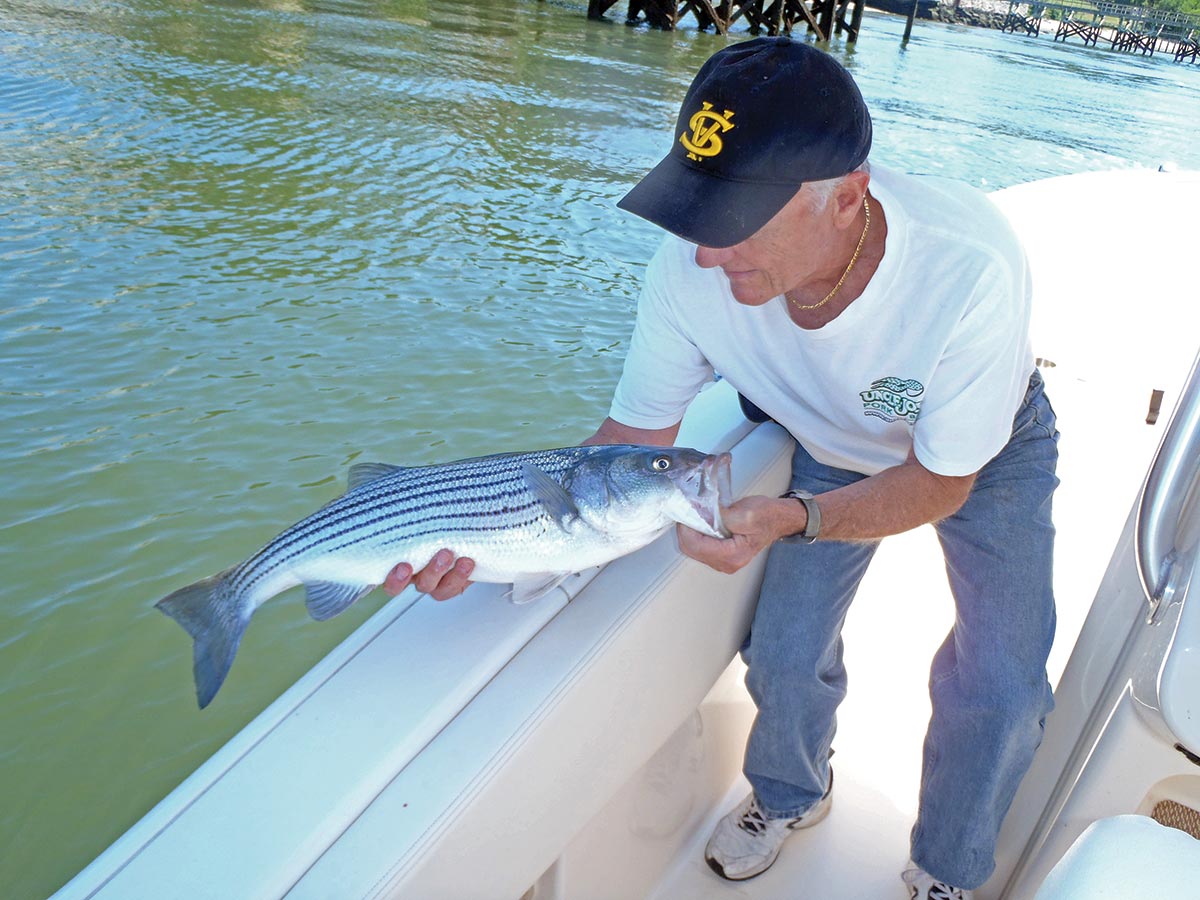
Leader: I use 20-pound test Perlon for leader material. On a 7-foot rod I like my leader to be 16 to 18 inches. I tie a very small 50-pound test Spro swivel between the running line and the Perlon, and a 75-pound Tactical Anglers paper-clip style snap on the other end. The small swivel and snap do not encumber the action of the lure yet provide plenty of strength to control and land fish safely and easily.
Lures: I keep lure choices simple. Bucktails and lead heads for soft plastics from 3/8 to 1 ounce and a few 1-ounce pencil poppers pretty much do it. Other lures aren’t needed, so why carry them? The color pallet of my lures is also simple. White is a common choice for bucktails, chrome or bone for pencil poppers, and you can’t go wrong with white or chartreuse for soft plastics.
Rod & Reel: I use a 7-foot Shimano Teramar rod. It is medium powered with a fast action tip. A fast tip is important in order to make long casts with light lures. This rod has plenty of power to handle a large fish, but at the same time allows even school fish to put a nice bend in the rod. My reel is a Van Staal 100. This makes for a nicely balanced outfit, reducing casting fatigue and allowing the angler to make consistently long and accurate casts.
Where
The answer is easy and short. Fish in your home harbor. The grass is not greener one or two harbors away. If you fish in your harbor you’ll save gas, wear and tear on the engine, get to know the key structure pieces of your home port, and discover how the fish tend to feed there. Each harbor has its idiosyncrasies due to shape, depth, current flow, and bottom contours. Therefore, in one harbor the stripers may have a tendency to feed near high water and in another near low water or some place in between. It is unlikely that an angler will discover these windows of opportunity while spending a lot of time running from harbor to harbor. Of course, bait is the key, and some years bait is not abundant. In such times, we fish elsewhere for other fish such as porgies, fluke, or blackfish. Most years there’s enough bait to gather school fish; especially by the end of July.
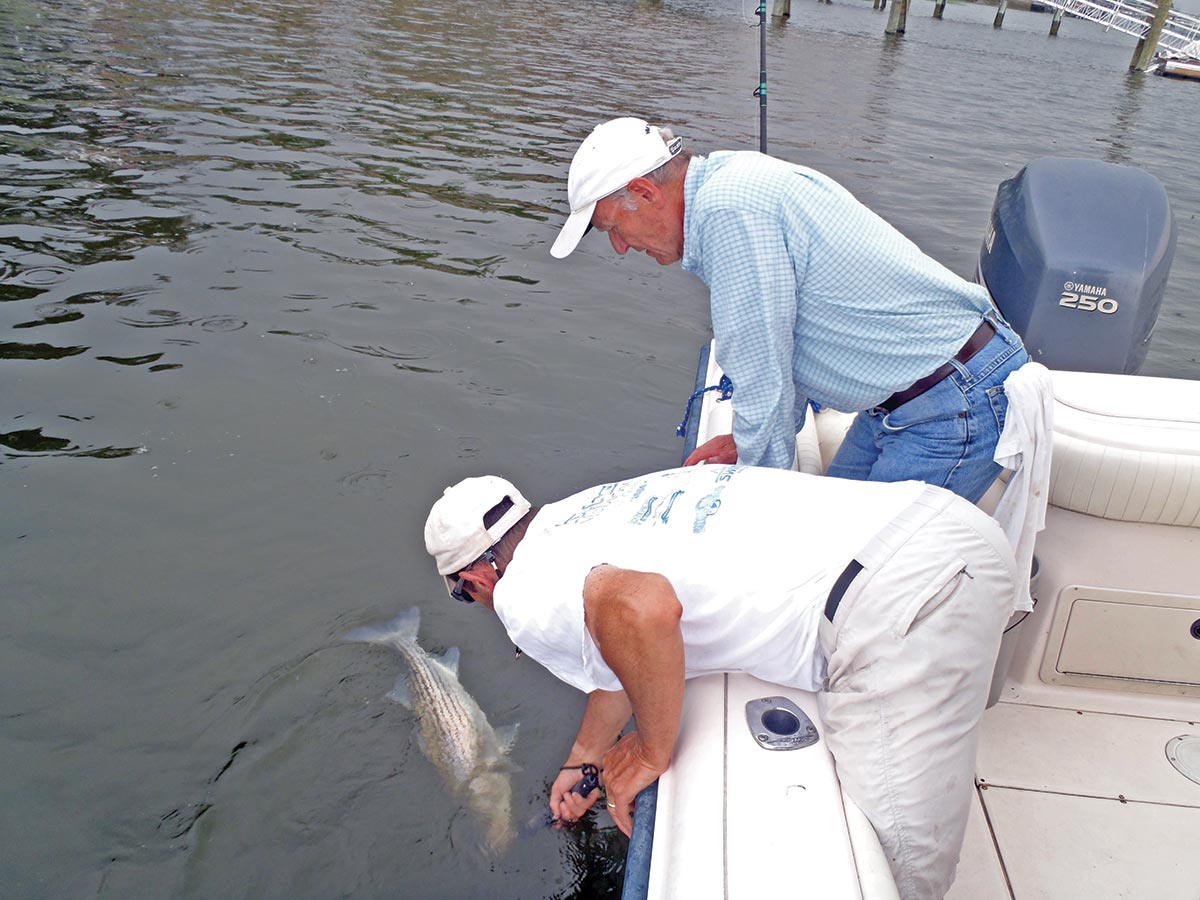
Techniques & Strategies
There are two parts to the actual fishing. One is using the boat, and the second involves lure presentations. These two pieces need to be used in concert. For example, if you put the boat in neutral without stopping the boat, the boat may cruise past the feeding zone or worse, run over the fish and scare them away. All the good accurate casting in the world won’t help if you run over the fish, even in neutral.
Rich and I keep the motor running. It is a 4-cycle engine and very quiet. Research has shown that fish aren’t spooked by steady noise, but are by sudden changes in noise level. Restarting an engine produces a sudden burst of noise that will alter fish behavior in shallow water. When we move, we simply nudge the motor into gear without accelerating, into neutral at the feeding zone, and nudge the motor into reverse to stop forward progress. This maneuver positions the boat so both of us can easily reach the feeding zone. Effective boat handling requires the angler to consider wind speed and direction, the position of structure pieces, the angle of the boat to the feeding zone, and any current that exists. If the boat is not positioned and stopped correctly, skill with rod and reel will have less effect on success. Boat handling is one of the most overlooked aspects of fishing by watercraft, yet one of the most important.
Once the boat is well-positioned, the focus turns to the angler. Casts must be made accurately in order to reach the feeding zone and far enough that the angler has time to allow the lure to settle into the strike zone at the right depth, speed, and action. This may seem like a lot of detail for a day of fun on the water, and it is. However, that’s a consequence of the reality of today’s fishing scene. There is a choice; a fisherman can either ignore the details and have less success, or heed the details and consistently catch fish and consistently have fun. The old saying goes, “the devil is in the details.”
Presentation
Cast and straight retrieve tactics may have often been successful when I was a young man. Today, varied lure presentations have become crucial to success and that’s why they’re talked and written about so much. Surface lures have a limited array of retrieve options: basically, slower or faster. I tend to retrieve pencil poppers slowly and with a wide side to side motion when the water is calm, and a little faster when there’s a chop or waves. Generally, I retrieve standard poppers slowly; especially for stripers, with a pop that’s more like a sloshing spray followed by an easy retrieve between pops that allows the popper to swing and sway. Super Strike Little Neck Poppers (black eye) and Gibbs Polaris Poppers swim this way when retrieved slowly.
Subsurface lures are different because they are under the water allowing the angler to work the lure in different parts of the water column. Furthermore, speed variation affects the position in the water column and can be used to mimic a number of live bait behaviors. A long, long time ago I learned to listen to the fish rather than insist they respond to what I was doing with the lure. So, I try to pick up hints from the fish’s reactions to my presentations, and alter my technique in order to make a better match to the size, shape, speed, and evasive motions of various baits. Bucktails and lead-heads with soft plastics permit a number of retrieves. I begin with a moderate straight retrieve intended to keep the lure about 1 to 2 feet above the bottom. If there is no response or only a few “bumps” I switch to a stutter retrieve where I reel for a while, then stop, and then return to moderate speed. I also try a “snap” retrieve that involves a straight retrieve with an occasional upward snap of my wrist and a return to normal. Of course, an angler can change the depth of the lure in two ways: increasing and decreasing weight, and increasing or decreasing the speed of the retrieve.
The standard straight retrieve may produce nothing or limited response, but any response suggests to me that varying the factors might lead to better results. Finding the exact combination of factors is in reality a trial and error process. A caution is needed here, however. Don’t make only a few casts when you a change lure or modify the retrieve, and then change again. Instead, stick with the changes for at least a dozen casts and tweak it as you go in order to develop a solid data base. Switch quickly, catch seldom, is my motto.
